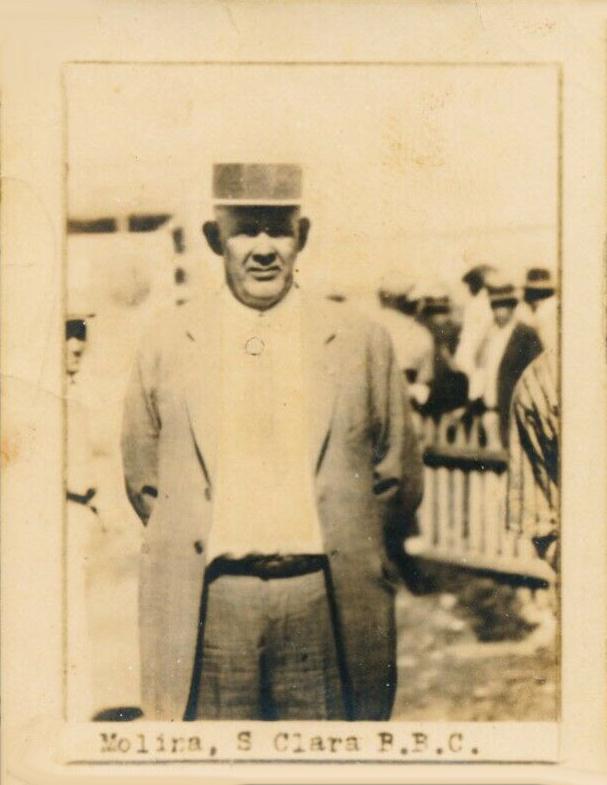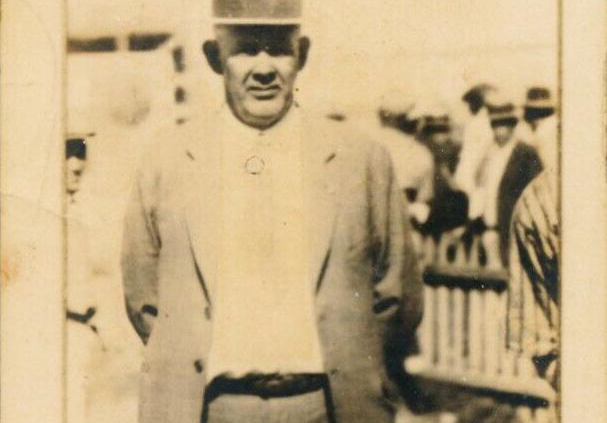May 9, 1920: The first all-Latino lineup in major-league baseball
 On September 15, 2022 – celebrated as Roberto Clemente Day across all of baseball’s major leagues – the Tampa Bay Rays, playing the Toronto Blue Jays at the Rogers Centre in Toronto, deployed a batting order of players native to Colombia, Cuba, the Dominican Republic, Mexico, and Venezuela. The Rays won the game, 11-0, and postgame coverage billed it as “MLB’s first all-Latino lineup.”1
On September 15, 2022 – celebrated as Roberto Clemente Day across all of baseball’s major leagues – the Tampa Bay Rays, playing the Toronto Blue Jays at the Rogers Centre in Toronto, deployed a batting order of players native to Colombia, Cuba, the Dominican Republic, Mexico, and Venezuela. The Rays won the game, 11-0, and postgame coverage billed it as “MLB’s first all-Latino lineup.”1
That distinction, however, has two significant qualifications.
First, “all-Latino” accurately described Tampa Bay’s batting order, but the Rays’ starting pitcher, who did not bat because of the designated hitter, was Shane McClanahan, a Baltimore native. When Panamanian Javy Guerra pitched in relief in the bottom of the eighth, Harold Ramírez was no longer in the game, replaced at second by Taylor Walls. Thus, by the time the Rays had a Latino on the mound, they no longer had an all-Latino lineup.
Moreover, coverage of the 2022 game appears to have used “MLB” as shorthand for the American League, National League, and other formerly segregated White-only major leagues.2 In December 2020, however, MLB had retroactively recognized seven of the Negro Leagues as major leagues.3 This opened up the possibility that a “major league” team had fielded an all-Latino lineup years before the Rays.
As it happened, the initial Negro National League, founded by Rube Foster, included a Cuban Stars team – known historically as “Cuban Stars West” – in its eight-club ranks when league play opened in 1920.
While Tampa Bay’s 2022 “all-Latino” lineup reflected increasing inclusiveness in the once-segregated majors – starting with pre-1947 players like Cuban Dolf Luque, Mexican Mel Almada, and Puerto Rican Hi Bithorn, then accelerating after Jackie Robinson integrated baseball and the game’s popularity grew worldwide4 – the Cuban Stars were, from their inception, a team of Cuba-born players.
Owned by Abel Linares and managed by Tinti Molina, as of 1910, versions of the Cuban Stars had barnstormed in the United States since 1906, often competing against the independent Black teams that also were the roots of Foster’s league.
They joined the Negro National League in 1920, a time when baseball’s color line had some fluidity for Cuban natives. Luque appeared in 37 games as a Cincinnati Reds’ swingman in 1920, on his way to a 20-season National League career. Catcher Mike González had played in over 100 games with the St. Louis Cardinals each season from 1916 through 1918. One member of the Cuban Stars, Ramon “Mike” Herrera, went on to appear in 84 games with the Boston Red Sox in 1925 and 1926.5
When the Negro National League season opened in the spring of 1920, Linares and Molina’s Cuban Stars were a “traveling team,” participating in the league without a dedicated home field. They opened their schedule on May 9, with a Saturday afternoon doubleheader against the Indianapolis ABCs in Indianapolis. Every member of the Cuban Stars’ roster was born in Cuba, making their lineup against the ABCs – pitcher José Leblanc, catcher Eufemio Abreu, first baseman Marcelio Guerra, second baseman José López, third baseman Herrera, shortstop Matías Ríos, left fielder Valentin Dreke, center fielder Bernardo Baró, and right fielder Faustino Valdés – the first all-Latino lineup in a major league.
Starting for C.I. Taylor’s Indianapolis ABCs was 33-year-old right-hander Dicta Johnson, long established as one of Black baseball’s top starting pitchers. Leblanc, a 27-year-old righty from Cienfuegos, took the mound for Molina’s Cuban Stars. The Indianapolis Star estimated attendance at 10,000, “the largest crowd that the local colored stars have ever played before in Indianapolis.”6
Johnson held the Cubans scoreless in the top of the first, and Indianapolis scored two runs against Leblanc in the bottom of the inning.
Neither team scored again until the fifth inning when the Cubans put one run across. The ABCs immediately matched that with another run of their own in the bottom of the fifth, making it 3-1.
In the top of the seventh, the Cubans scored again, closing the gap to one run, but Indianapolis added another run in the bottom of the eighth.
A Cubans rally was squelched by Oscar Charleston in the top of the ninth. The 24-year-old Indianapolis center fielder, described by the Star as the “Black Ty Cobb” and inducted into the National Baseball Hall of Fame in 1976, saved the day. He had already made two “sensational catches” earlier in the game. In the ninth there were two outs, but the Cuban Stars had two men on base. Leblanc, the pitcher, was up to hit.
Characterized by the Indianapolis Star as “one of the heavy hitters with the visitors,” Leblanc “drove a long fly ball to deep center. … Charleston, with his back to the stands, leaped high in the air to pull down the ball, and so delighted were a number of the A.B.C. followers that they ran out on the field and greeted him with hands full of money.”7
The ball had been hit “far out in left center. It looked like a certain triple until Charleston speared it out of the air, thereby saving the game for the locals … a great catch because Charleston was running with his back to the stands at the time.”8
The Indianapolis News concurred, also recognizing some solid defense from the visitors: “The Cubans also cut in with some nice work in the field, their young shortstop playing particularly well.”9
There were no home runs in either of the day’s games. There was one triple in the first game, by Cubans catcher Abreu. Both ABCs first baseman Ben Taylor and catcher Russell Powell had two-base hits. Charleston had two hits, both singles.
The Cubans committed four errors – two by Guerra and one each by Ríos and Herrera. ABCs shortstop Morten Clark and third baseman Connie Day were charged with errors.
Leblanc struck out four. Johnson struck out five. Leblanc was charged with one balk. There were three stolen bases – López for the Cubans, and Indianapolis right fielder Jim Jeffries and left fielder George Shively.
The day’s second game was won by the same 4-2 score but was cut short in the sixth inning because of a 6:00 P.M. curfew. The pitchers had been Dizzy Dismukes for Indianapolis and José “Cheo” Hernández for the Cuban Stars.10 Dismukes walked two but gave up only two hits, one of them a double by Guerra. Hernández gave up five hits, including triples by Ben Taylor and Shively. He walked three.
At season’s end, the Chicago American Giants were first in the Negro National League standings.11 The ABCs (44-38, with 4 ties) finished in fourth place, 10 games behind. The Cuban Stars (35-34) finished fifth, 12½ games back.
In 1921 the Cuban Stars played their home schedule at Cincinnati’s Redland Field, home of the NL’s Reds. They competed in the Negro National League through the 1930 season.
Author’s Note
Thanks to Thomas Van Hyning for inspiring this article. A baseball historian and researcher with a particular interest in Caribbean baseball, Van Hyning undertook to determine if there had ever been an all-Latino lineup in the 1920-1948 period during which one or more of the seven Negro Leagues – now regarded as major leagues – had operated. He identified the May 9, 1920, doubleheader between the Cuban Stars and ABCs in Indianapolis which preceded the September 15, 2022, Tampa Bay Rays all-Latino lineup by 102 years, 4 months, and 6 days.
Van Hyning also found that the eight “regulars” with the 1941 New York Cubans were from Cuba (5), Dominican Republic (2), and Puerto Rico (1), per Seamheads.com.
Acknowledgments
Thanks to John Fredland and Kurt Blumenau for working on this article. It was fact-checked by Laura Peebles and copy-edited by Len Levin.
Photo credit: Tinti Molina, Trading Card Database.
Sources
All data is as presented on the Seamheads.com website. The author also consulted Baseball-Reference.com and Retrosheet.org for pertinent information. Thanks to Gary Ashwill of Seamheads for supplying newspaper accounts of the game.
Notes
1 See, for instance, Adam Berry, “Rays Field MLB’s First All-Latino Lineup on Clemente Day,” MLB.com, September 15, 2022. https://www.mlb.com/news/rays-lineup-all-latino-players-on-roberto-clemente-day, and Austin Nivison, “Rays Make History by Starting MLB’s First All-Latino Lineup on Roberto Clemente Day,” CBSSports.com, September 15, 2022. https://www.cbssports.com/mlb/news/rays-make-history-by-starting-mlbs-first-all-latino-lineup-on-roberto-clemente-day/.
2 There was no such entity as MLB before the last year or two of the twentieth century. Bill Nowlin, “Did MLB Exist before the Year 2000?” Baseball Research Journal, Fall 2019: 63-66.
3 “MLB Officially Designates the Negro Leagues as ‘Major League,’” MLB.com, December 16, 2020. https://www.mlb.com/press-release/press-release-mlb-officially-designates-the-negro-leagues-as-major-league.
4 Notably, Osvaldo “Ozzie” Virgil Sr. became the first native of the Dominican Republic to play in the National or American League when he debuted with the New York Giants in 1956, leading a surge of Dominican talent in the major leagues. See Bill Nowlin and Julio C. Rodriguez, eds., Dominicans in the Major Leagues (Phoenix: SABR, 2022).
5 This is the same player known as Mike Herrera, who played in 84 games for the Boston Red Sox in 1925 and 1926, batting .275 with 27 RBIs. The Red Sox are known as the last team in the American and National Leagues to have fielded a Black player – Pumpsie Green in 1959. It is interesting that Herrera played in the Negro Leagues both before and after his time with the Red Sox.
6 “Great Playing Beats Cubans,” Indianapolis Star, May 10, 1920: 12. All gameplay information is drawn from this article unless otherwise indicated.
7 The Star used the word “sands” but that was clearly a typographical error.
8 “A.B.C.s and Islanders Resume Play; Charleston Shines in Sunday Bill,” Indiana Daily Times (Indianapolis), May 10, 1920.
9 “A.B.C.s and Cubans Get Together in Third Game,” Indianapolis News, May 10, 1920: 16.
10 Hernández played five seasons in “organized baseball” – in the Florida State League, 1921-1924 and 1927.
11 See Frederick C. Bush and Bill Nowlin, eds., The First Negro League Champion: The 1920 Chicago American Giants (Phoenix: SABR, 2022).
Additional Stats
Indianapolis ABCs 4
Cuban Stars West 2
Game 1, DH
Washington Park
Indianapolis, IN
Corrections? Additions?
If you can help us improve this game story, contact us.


